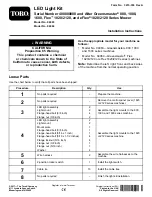
17
R
Section 4
AFTER OPERATION
4.9
Wash the entire mower after each use. Do not
1.
use high pressure spray or direct the spray onto
electrical components.
- IMPORTANT -
Do not wash a hot or running engine. Cold water
will damage the engine. Use compressed air to
clean the engine if it is hot.
Keep the entire mower clean to inhibit serious heat
2.
damage to the engine or hydraulic oil circuit.
Check the drive belts for proper alignment and any
3.
signs of wear. Correct and adjust if necessary.
DANGER
To avoid injury from burns, allow the mower
to cool before removing the fuel tank cap and
refueling.
Check the tire pressure. Adjust pressure if
4.
necessary.
REMOvING CLOGGED MATERIAL
4.10
DANGER
ROTATING BLADES
NEvER PUT YOUR HANDS INTO THE DISCHARGE
CHUTE FOR ANY REASON!
Shut off the engine and remove the key and
only then use a stick or similar object to remove
material if clogging has occurred.
If the discharge chute becomes clogged, shut off
1.
the engine and remove the ignition key. Using a stick
or similar item, dislodge the clogged material. Then
resume normal mowing.
MOvING MOWER WITH ENGINE
4.11
STOPPED
To “free-wheel” or move the mower around without the
engine running, move the dump valve control levers back
and towards the engine. See Figure 4-6. Disengage the
parking brake and move the mower by hand. When the
machine is in the desired position, engage the parking
brake and forward until they stop. The dump valve levers
must be returned to the DRIVE position to drive the
mower.
DUMP VALVE
CONTROL LEVER
"FREEWHEEL" POSITION
2012 SCZ48 52 DVL
DUMP VALVE
CONTROL LEVER
"FREEWHEEL" POSITION
Dump Valve Control
Figure 4-6.
RECOMMENDATIONS FOR MOWING
4.12
Do not mow with dull blades. A dull blade will tear
1.
grass, resulting in poor lawn appearance and
reduced mowing power.
WARNING
DO NOT operate without Discharge Chute,
Mulching kit, or entire Grass Catcher properly
installed.
The discharge chute must not be removed and
2.
must be kept in the lowest position to deflect grass
clippings and thrown objects downward. Direct the
side discharge away from sidewalks or streets to
minimize cleanup of clippings. When mowing close
to obstacles, direct the discharge away from the
obstacles to reduce the chance of property damage
by thrown objects. Do not mow when bystanders are
present.
Cut grass when it is dry and not too tall. Do not cut
3.
grass too short (cut off 1/3 or less of existing grass
for best appearance). Mow frequently.
Keep mower and discharge chute clean.
4.
















































